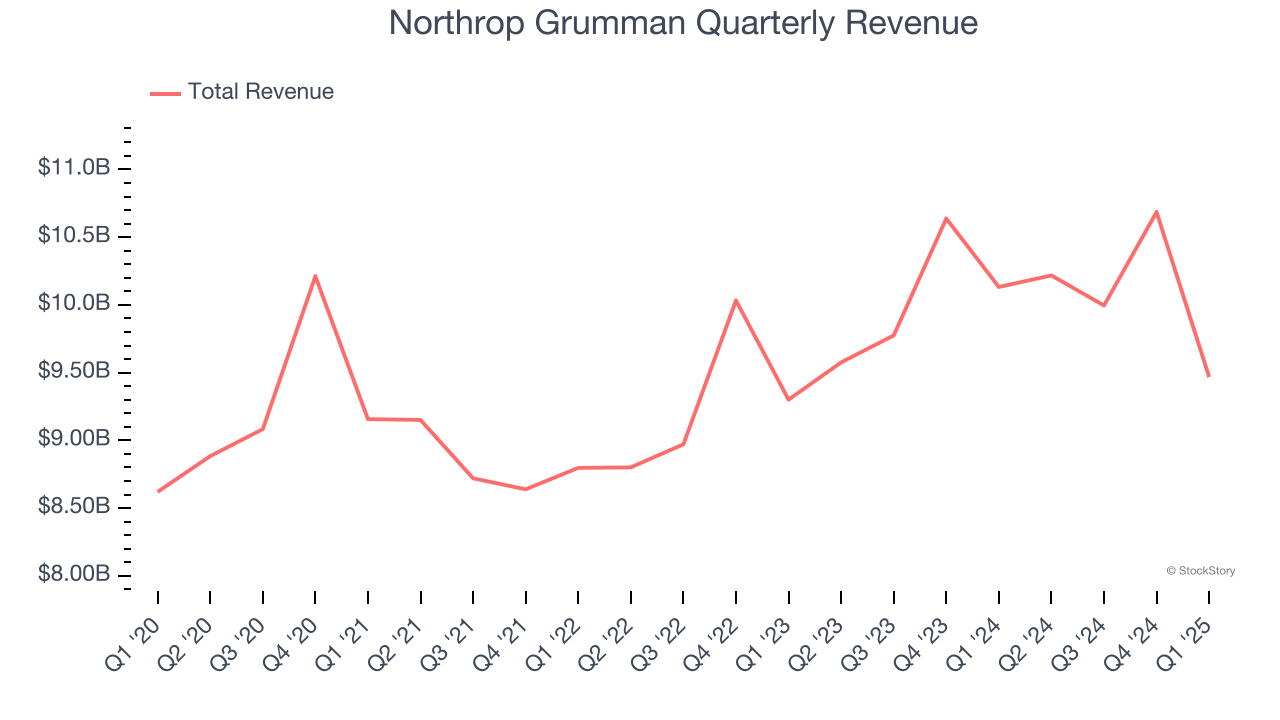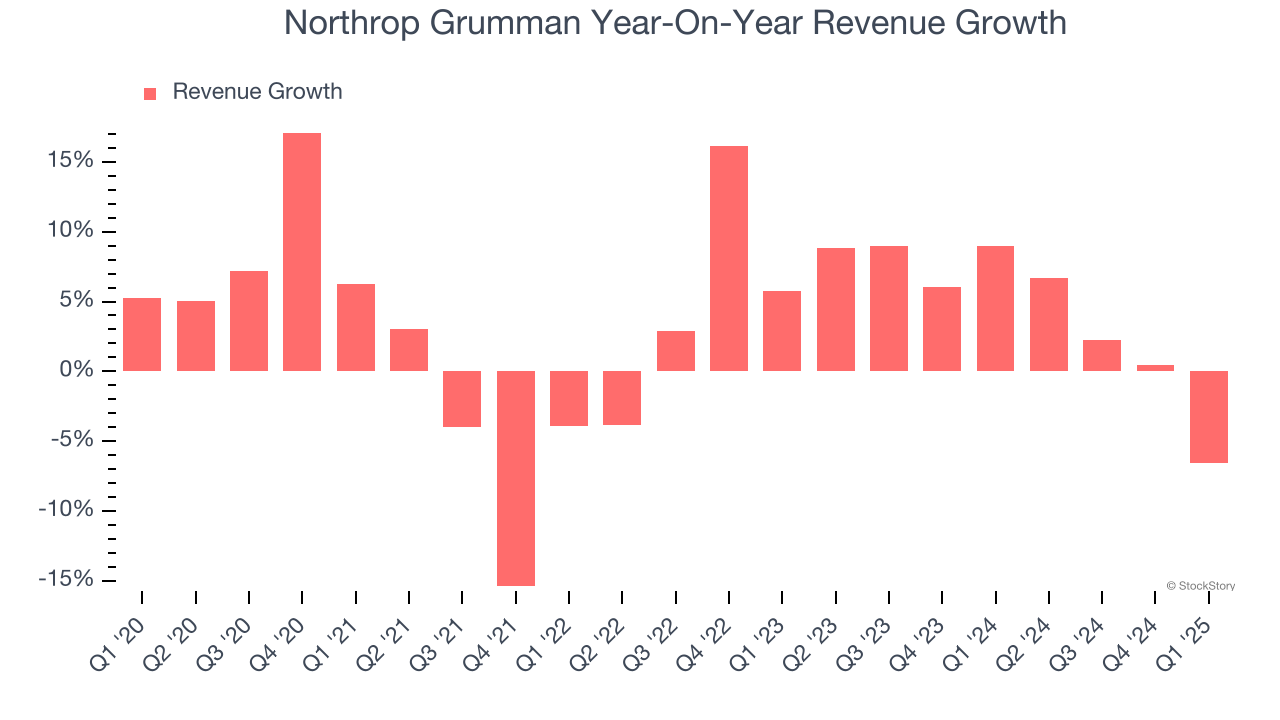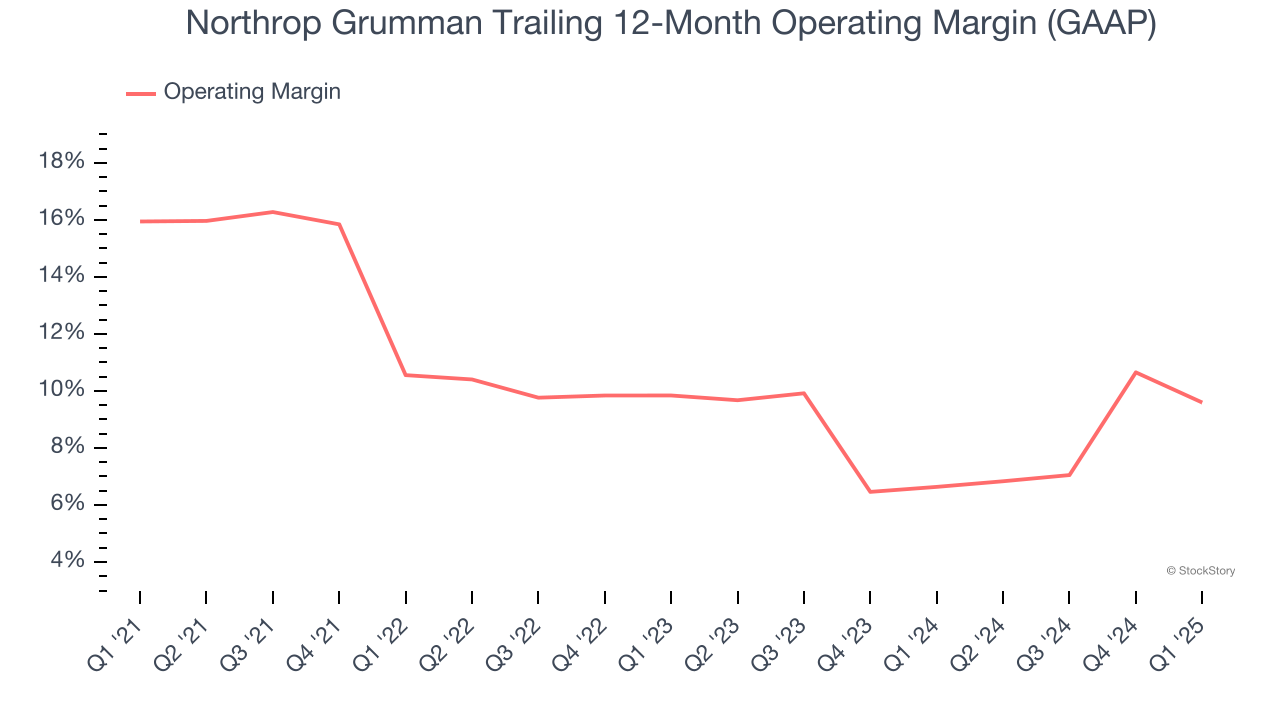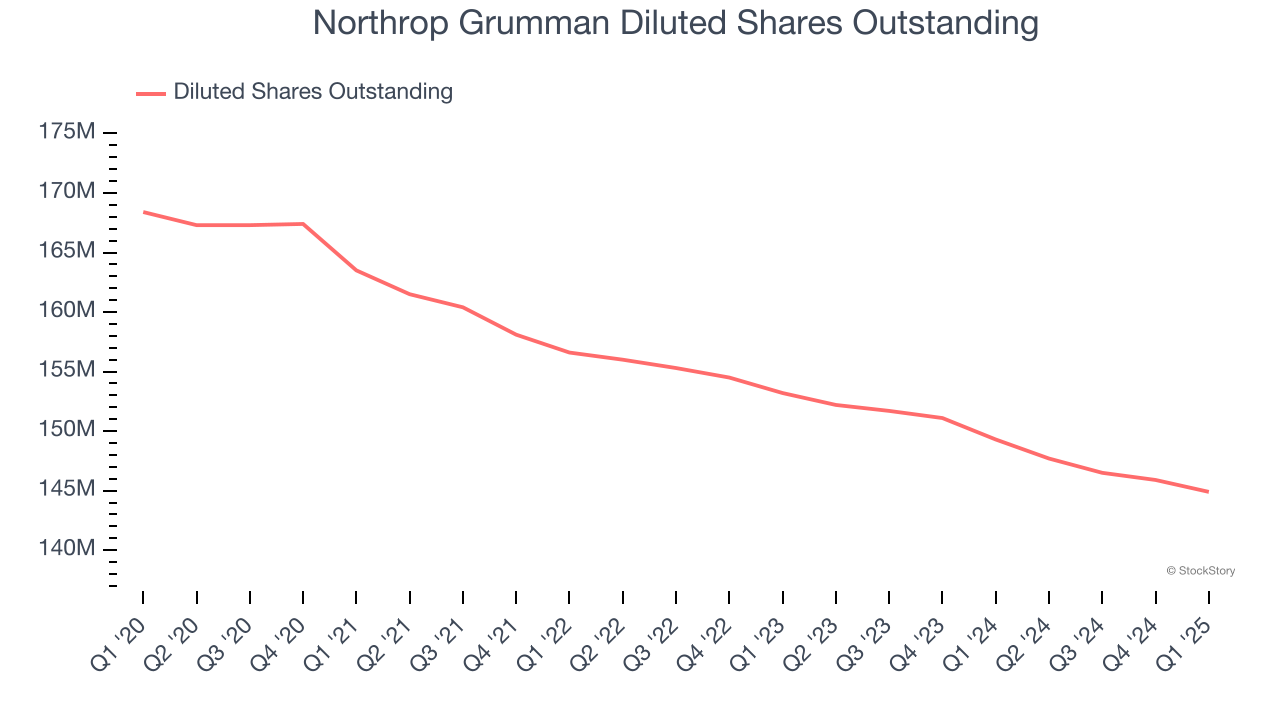
Security and aerospace company Northrop Grumman (NYSE: NOC) missed Wall Street’s revenue expectations in Q1 CY2025, with sales falling 6.6% year on year to $9.47 billion. On the other hand, the company’s outlook for the full year was close to analysts’ estimates with revenue guided to $42.25 billion at the midpoint. Its GAAP profit of $3.32 per share was 46.7% below analysts’ consensus estimates.
Is now the time to buy Northrop Grumman? Find out by accessing our full research report, it’s free.
Northrop Grumman (NOC) Q1 CY2025 Highlights:
- Revenue: $9.47 billion vs analyst estimates of $9.93 billion (6.6% year-on-year decline, 4.6% miss)
- EPS (GAAP): $3.32 vs analyst expectations of $6.23 (46.7% miss)
- Adjusted EBITDA: $930 million vs analyst estimates of $1.39 billion (9.8% margin, 32.9% miss)
- The company reconfirmed its revenue guidance for the full year of $42.25 billion at the midpoint
- Operating Margin: 6.1%, down from 10.6% in the same quarter last year
- Free Cash Flow was -$1.82 billion compared to -$976 million in the same quarter last year
- Backlog: $92.8 billion at quarter end
- Market Capitalization: $76.59 billion
Company Overview
Responsible for the development of the first stealth bomber, Northrop Grumman (NYSE: NOC) specializes in providing aerospace, defense, and security solutions for various industry applications.
Defense Contractors
Defense contractors typically require technical expertise and government clearance. Companies in this sector can also enjoy long-term contracts with government bodies, leading to more predictable revenues. Combined, these factors create high barriers to entry and can lead to limited competition. Lately, geopolitical tensions–whether it be Russia’s invasion of Ukraine or China’s aggression towards Taiwan–highlight the need for defense spending. On the other hand, demand for these products can ebb and flow with defense budgets and even who is president, as different administrations can have vastly different ideas of how to allocate federal funds.
Sales Growth
A company’s long-term sales performance is one signal of its overall quality. Any business can put up a good quarter or two, but many enduring ones grow for years. Over the last five years, Northrop Grumman grew its sales at a sluggish 3.3% compounded annual growth rate. This fell short of our benchmark for the industrials sector and is a tough starting point for our analysis.

We at StockStory place the most emphasis on long-term growth, but within industrials, a half-decade historical view may miss cycles, industry trends, or a company capitalizing on catalysts such as a new contract win or a successful product line. Northrop Grumman’s annualized revenue growth of 4.3% over the last two years aligns with its five-year trend, suggesting its demand was consistently weak. 
This quarter, Northrop Grumman missed Wall Street’s estimates and reported a rather uninspiring 6.6% year-on-year revenue decline, generating $9.47 billion of revenue.
Looking ahead, sell-side analysts expect revenue to grow 6% over the next 12 months. While this projection suggests its newer products and services will spur better top-line performance, it is still below average for the sector.
Here at StockStory, we certainly understand the potential of thematic investing. Diverse winners from Microsoft (MSFT) to Alphabet (GOOG), Coca-Cola (KO) to Monster Beverage (MNST) could all have been identified as promising growth stories with a megatrend driving the growth. So, in that spirit, we’ve identified a relatively under-the-radar profitable growth stock benefiting from the rise of AI, available to you FREE via this link.
Operating Margin
Northrop Grumman has managed its cost base well over the last five years. It demonstrated solid profitability for an industrials business, producing an average operating margin of 10.4%.
Looking at the trend in its profitability, Northrop Grumman’s operating margin decreased by 6.4 percentage points over the last five years. This raises questions about the company’s expense base because its revenue growth should have given it leverage on its fixed costs, resulting in better economies of scale and profitability.

This quarter, Northrop Grumman generated an operating profit margin of 6.1%, down 4.5 percentage points year on year. This contraction shows it was less efficient because its expenses increased relative to its revenue.
Earnings Per Share
Revenue trends explain a company’s historical growth, but the long-term change in earnings per share (EPS) points to the profitability of that growth – for example, a company could inflate its sales through excessive spending on advertising and promotions.
Northrop Grumman’s EPS grew at a remarkable 13.8% compounded annual growth rate over the last five years, higher than its 3.3% annualized revenue growth. However, this alone doesn’t tell us much about its business quality because its operating margin didn’t expand.

Diving into the nuances of Northrop Grumman’s earnings can give us a better understanding of its performance. A five-year view shows that Northrop Grumman has repurchased its stock, shrinking its share count by 14%. This tells us its EPS outperformed its revenue not because of increased operational efficiency but financial engineering, as buybacks boost per share earnings. 
Like with revenue, we analyze EPS over a more recent period because it can provide insight into an emerging theme or development for the business.
For Northrop Grumman, its two-year annual EPS declines of 9.4% mark a reversal from its (seemingly) healthy five-year trend. We hope Northrop Grumman can return to earnings growth in the future.
In Q1, Northrop Grumman reported EPS at $3.32, down from $6.32 in the same quarter last year. This print missed analysts’ estimates, but we care more about long-term EPS growth than short-term movements. Over the next 12 months, Wall Street expects Northrop Grumman’s full-year EPS of $25.35 to grow 12.8%.
Key Takeaways from Northrop Grumman’s Q1 Results
We struggled to find many positives in these results. Its revenue missed significantly and its EBITDA fell short of Wall Street’s estimates. Overall, this was a softer quarter. The stock traded down 8.6% to $485 immediately following the results.
Northrop Grumman underperformed this quarter, but does that create an opportunity to invest right now? The latest quarter does matter, but not nearly as much as longer-term fundamentals and valuation, when deciding if the stock is a buy. We cover that in our actionable full research report which you can read here, it’s free.


